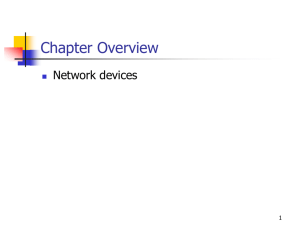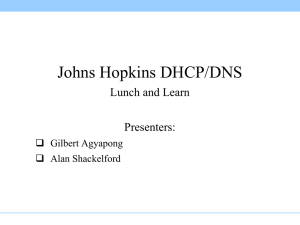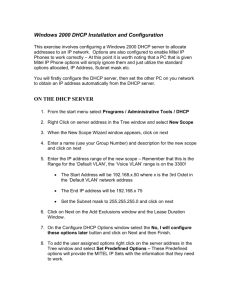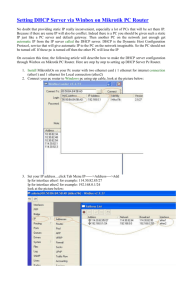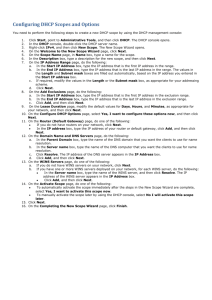module18
advertisement
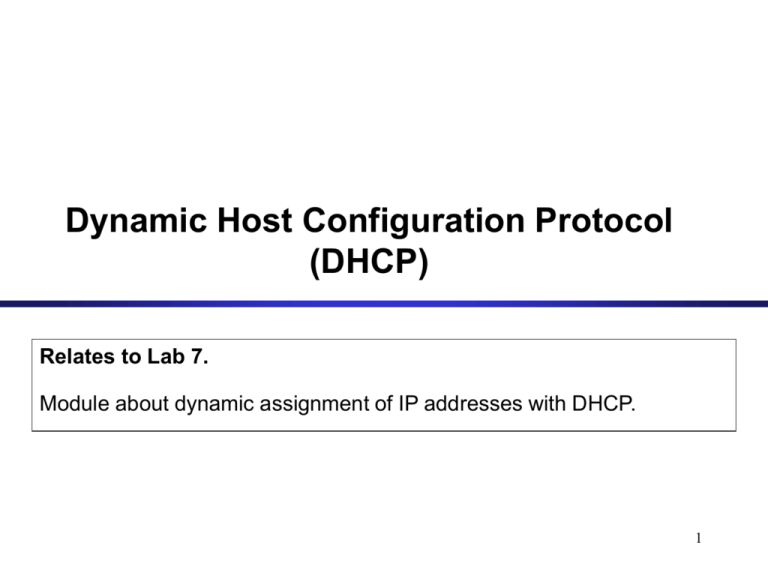
Dynamic Host Configuration Protocol (DHCP) Relates to Lab 7. Module about dynamic assignment of IP addresses with DHCP. 1 Dynamic Assignment of IP addresses • Dynamic assignment of IP addresses is desirable for several reasons: – IP addresses are assigned on-demand – Avoid manual IP configuration – Support mobility of laptops 2 Solutions for dynamic assignment of IP addresses • Reverse Address Resolution Protocol (RARP) – Works similar to ARP – Broadcast a request for the IP address associated with a given MAC address – RARP server responds with an IP address – Only assigns IP address (not the default router and subnetmask) IP address (32 bit) ARP RARP Ethernet MAC address (48 bit) 3 BOOTP • BOOTstrap Protocol (BOOTP) • From 1985 • Host can configure its IP parameters at boot time. • 3 services. – IP address assignment. – Detection of the IP address for a serving machine. – The name of a file to be loaded and executed by the client machine (boot file name) – Not only assign IP address, but also default router, network mask, etc. – Sent as UDP messages (UDP Port 67 (server) and 68 (host)) – Use limited broadcast address (255.255.255.255): • These addresses are never forwarded 4 DHCP • Dynamic Host Configuration Protocol (DHCP) – From 1993 – An extension of BOOTP, very similar to DHCP – Same port numbers as BOOTP – Extensions: • Supports temporary allocation (“leases”) of IP addresses • DHCP client can acquire all IP configuration parameters needed to operate – DHCP is the preferred mechanism for dynamic assignment of IP addresses – DHCP can interoperate with BOOTP clients. 5 BOOTP Interaction (a) Argon 00:a0:24:71:e4:44 BOOTP Server Argon 128.143.137.144 00:a0:24:71:e4:44 (b) DHCP Server BOOTP Response: IP address: 128.143.137.144 Server IP address: 128.143.137.100 Boot file name: filename BOOTP Request 00:a0:24:71:e4:44 Sent to 255.255.255.255 (c) • BOOTP can be used for downloading memory image for diskless workstations • Assignment of IP addresses to hosts is static 6 DHCP Interaction (simplified) Argon 128.143.137.144 00:a0:24:71:e4:44 DHCP Server DHCP Response: IP address: 128.143.137.144 Default gateway: 128.143.137.1 Netmask: 255.255.0.0 7 BOOTP/DHCP Message Format OpCode Hardware Type Number of Seconds Hardware Address Hop Count Length Unused (in BOOTP) Flags (in DHCP) Transaction ID Client IP address Your IP address Server IP address Gateway IP address Client hardware address (16 bytes) Server host name (64 bytes) Boot file name (128 bytes) Options (There are >100 different options) 8 Message Fields • • • • code: Indicates a request or a reply – 1 Request – 2 Reply HWtype: The type of hardware, for example: – 1 Ethernet – 6 IEEE 802 networks length: Hardware address length in bytes. E.g., Ethernet and token-ring both use 6 bytes. hops: The client sets this to 0. It is incremented by a router that relays the request to another server and is used to identify loops. RFC 951 suggests that a value of 3 indicates a loop. 9 Contd. • • • Transaction ID: A random number used to match this boot request with the response it generates. Seconds: Set by the client. It is the elapsed time in seconds since the client started its boot process. Flags field: The most significant bit of the flags field is used as a broadcast flag. All other bits must be set to zero, and are reserved for future use. Normally, DHCP servers attempt to deliver DHCP messages directly to a client using unicast delivery. The destination address in the IP header is set to the DHCP your IP address and the MAC address is set to the DHCP client hardware address. If a host is unable to receive a unicast IP datagram until it knows its IP address, then this broadcast bit must be set (=1) to indicate to the server that the DHCP reply must be sent as an IP and MAC broadcast. Otherwise this bit must be set to zero. 10 Contd. • • • • • Client IP address: Set by the client. Either its known IP address, or 0.0.0.0. Your IP address: Set by the server if the client IP address field was0.0.0.0. Server IP address: Set by the server. Router IP address: This is the address of a BOOTP relay agent, not a general IP router to be used by the client. It is set by the forwarding agent when BOOTP forwarding is being used Client hardware address: Set by the client. DHCP defines a client identifier option that is used for client identification. If this option is not used the client is identified by its MAC address. 11 Contd. • • • Server host name: Optional server host name terminated by X'00'. Boot file name: The client either leaves this null or specifies a generic name, such as router, indicating the type of boot file to be used. In a DHCPDISCOVER request this is set to null. The server returns a fully qualified directory path name in a DHCPOFFER request. The value is terminated by X'00'. Options: Subnet Mask, Name Server, Hostname, Domain Name, Forward On/Off, Default IP TTL, Broadcast Address, Static Route, Ethernet Encapsulation, X Window Manager, X Window Font, DHCP Msg Type, DHCP Renewal Time, DHCP Rebinding, Time SMTP-Server, SMTP-Server, Client FQDN, Printer Name, … 12 DHCP Message Type • Message type is sent as an option. Value Message Type 1 DHCPDISCOVER 2 DHCPOFFER 3 DHCPREQUEST 4 DHCPDECLINE 5 DHCPACK 6 DHCPNAK 7 DHCPRELEASE 8 DHCPINFORM 13 Message Types • • • DHCPDISCOVER: Broadcast by a client to find available DHCP servers. DHCPOFFER: Response from a server to a DHCPDISCOVER and offering IP address and other parameters. DHCPREQUEST: Message from a client to servers that does one of the following: – Requests the parameters offered by one of the servers and declines all other offers. – Verifies a previously allocated address after a system or network change (a reboot for example). – Requests the extension of a lease on a particular address. 14 Contd. • • • • • • DHCPACK: Acknowledgement from server to client with parameters, including IP address. DHCPNACK: Negative acknowledgement from server to client, indicating that the client's lease has expired or that a requested IP address is incorrect. DHCPDECLINE: Message from client to server indicating that the offered address is already in use. DHCPRELEASE: Message from client to server canceling remainder of a lease and relinquishing network address. DHCPINFORM: Message from a client that already has an IP address (manually configured for example), requesting further configuration parameters from the DHCP server. 15 DHCP Operation DHCP Client 00:a0:24:71:e4:44 • DHCP Server DHCPDISCOVER DCHP DISCOVER Sent to 255.255.255.255 DHCP Server DHCP Client 00:a0:24:71:e4:44 • DCHP OFFER DHCPOFFER DHCP Server DHCPOFFER DHCP Server 16 DHCP Operation DHCP Client 00:a0:24:71:e4:44 DHCP Server DHCPREQUEST • DCHP DISCOVER DHCPACK At this time, the DHCP client can start to use the IP address DHCP Server DHCP Client 00:a0:24:71:e4:44 DHCP Server DHCPREQUEST • Renewing a Lease (sent when 50% of lease has expired) If DHCP server sends DHCPNACK, then address is released. DHCPACK DHCP Server 17 DHCP Operation DHCP Client 00:a0:24:71:e4:44 DHCP Server DHCPRELEASE • DCHP RELEASE At this time, the DHCP client has released the IP address DHCP Server 18 Client Server Interactions • • The client broadcasts a DHCPDISCOVER message on its local physical subnet. – The DHCPDISCOVER message may include some options such as network address suggestion or lease duration. Each server may respond with a DHCPOFFER message that includes an available network address (your IP address) and other configuration options. – The servers record the address as offered to the client to prevent the same address being offered to other clients in the event of further DHCPDISCOVER messages being received before the first client has completed its configuration. 19 Contd. • The client receives one or more DHCPOFFER messages from one or more servers. – The client chooses one based on the configuration parameters offered and broadcasts a DHCPREQUEST message that includes the server identifier option to indicate which message it has selected and the requested IP address option, taken from your IP address in the selected offer. – In the event that no offers are received, if the client has knowledge of a previous network address, the client may reuse that address if its lease is still valid, until the lease expires. 20 Contd. • The servers receive the DHCPREQUEST broadcast from the client. – Those servers not selected by the DHCPREQUEST message use the message as notification that the client has declined that server's offer. – The server selected in the DHCPREQUEST message commits the binding for the client to persistent storage and responds with a DHCPACK message containing the configuration parameters for the requesting client. 21 Contd. • The combination of client hardware and assigned network address constitute a unique identifier for the client's lease and are used by both the client and server to identify a lease referred to in any DHCP messages. • The your IP address field in the DHCPACK messages is filled in with the selected network address. 22 Contd. • The client receives the DHCPACK message with configuration parameters. – The client performs a final check on the parameters, for example with ARP for allocated network address, and notes the duration of the lease and the lease identification cookie specified in the DHCPACK message. At this point, the client is configured. – If the client detects a problem with the parameters in the DHCPACK message (the address is already in use on the network, for example), the client sends a DHCPDECLINE message to the server and restarts the configuration process. 23 Contd. • The client should wait a minimum of ten seconds before restarting the configuration process to avoid excessive network traffic in case of looping. • On receipt of a DHCPDECLINE, the server must mark the offered address as unavailable (and possibly inform the system administrator that there is a configuration problem). • If the client receives a DHCPNAK message, the client restarts the configuration process. 24 Contd. • The client may choose to relinquish its lease on a network address by sending a DHCPRELEASE message to the server. • The client identifies the lease to be released by including its network address and its hardware address. 25 Lease Renewal • When a server sends the DHCPACK to a client with IP address and configuration parameters, it also registers the start of the lease time for that address. • This lease time is passed to the client as one of the options in the DHCPACK message, together with two timer values, T1 and T2. • The client is rightfully entitled to use the given address for the duration of the lease time. 26 Contd. • On applying the receive configuration, the client also starts the timers T1 and T2. At this time, the client is in the BOUND state. • Times T1 and T2 are options configurable by the server but T1 must be less than T2, and T2 must be less than the lease time. • According to RFC 2132, T1 defaults to (0.5 * lease time) and T2 defaults to (0.875 * lease time). 27 Contd. • • • • When timer T1 expires, the client will send a DHCPREQUEST (unicast) to the server that offered the address, asking to extend the lease for the given configuration. The client is now in the RENEWING state The server would usually respond with a DHCPACK message indicating the new lease time, and timers T1 and T2 are reset at the client accordingly. The server also resets its record of the lease time. Under normal circumstances, an active client would continually renew its lease in this way indefinitely, without the lease ever expiring. 28 Contd. • If no DHCPACK is received until timer T2 expires, the client enters the REBINDING state. • Client now broadcasts a DHCPREQUEST message to extend its lease. • This request can be confirmed by a DHCPACK message from any DHCP server on the network. 29 Contd. • If the client does not receive a DHCPACK message after its lease has expired, it has to stop using its current TCP/IP configuration. • The client may then return to the INIT state, issuing a DHCPDISCOVER broadcast to try and obtain any valid address. 30 Reusing a Previously allocated address • • • The client broadcasts a DHCPREQUEST message on its local subnet. – The DHCPREQUEST message includes the client's previously used network address. If the client’s lease is still current, the server with knowledge of the client's configuration parameters responds with a DHCPACK message to the client, renewing the lease at the same time. – The client must then proceed to test for the IP address. If the client's lease has expired, the server with knowledge of the client responds with DHCPNACK. – The client then must initiate a new IP address allocation process. 31 DHCP Pros • • • It relieves the network administrator of a great deal of manual configuration work. The ability for a device to be moved from network to network and to automatically obtain valid configuration parameters for the current network can be of great benefit to mobile users. Because IP addresses are only allocated when clients are actually active, it is possible, by the use of reasonably short lease times and the fact that mobile clients do not need to be allocated more than one address, to reduce the total number of addresses in use in an organization. 32 DHCP Cons • Uses UDP, an unreliable and insecure protocol. • DNS cannot be used for DHCP configured hosts. 33
